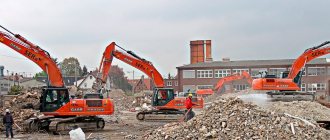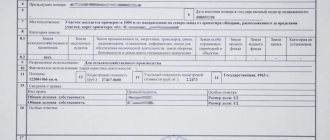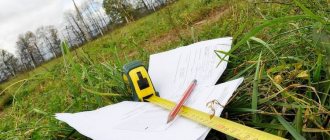What is deregistration of a land plot?
Removal of a land plot from registration in the state real estate cadastre (GKN) is a legal action declaring the loss of legal capacity of the plot.
After a land plot has been removed from the cadastral register, the plot ceases to function in its former capacity , or its destruction and loss of functional characteristics are confirmed, which does not allow the subsequent use of the land for its intended purpose and the extraction of profit from it.
What is it for?
The plot can be reorganized by dividing it into two or more plots. It is also possible to merge several sections into one.
If the reorganized lands are not deregistered, the newly formed plots will not be included in the registration records of the State Property Committee and will not receive independent cadastral numbers.
Sometimes lands are destroyed as a result of:
- military actions;
- natural disasters, incl. flood or fire;
- damage to the fertile soil layer due to man-made reasons;
- erosion of river beds;
- ravine collapse, etc.
In the above and other cases, the owner of the land plot continues to pay land tax, without being able to use the plot until he removes it from the cadastral register. Payment of rent also ceases at the moment of official registration of deregistration of the leasehold property.
Who conducts MKD inspections and why?
Monitoring the technical condition of the building is carried out through periodic inspections of structures, engineering support systems and utility networks (Clause 7, Article 55.24, Chapter 6.2 of the Civil Code of the Russian Federation).
Periodic inspections of the condition of an apartment building are carried out by the organization that manages it at least twice a year - in spring and autumn (clause 2.1.1 of the “Rules and Standards for the Technical Operation of the Housing Stock”, approved by Decree of the State Construction Committee of the Russian Federation dated September 27, 2003 No. 170).
Seasonal inspections help identify defects that have appeared on the elements of the house and draw up a work plan to eliminate them. As part of the inspection, control is carried out regarding the correct maintenance and operation of the premises of an apartment building, compliance with the requirements provided for in Art. 17 Housing Code of the Russian Federation.
The owners of premises in the apartment building and representatives of the organization managing the house participate in the inspections (clause 13 of the Decree of the Government of the Russian Federation of August 13, 2006 No. 491). If an organization manages a house in which a HOA (residential complex, housing cooperative) has been created, then the commission must include a representative of the HOA board, this is provided for in clause 2.1.2 of Rules No. 170.
Who is eligible?
These legal actions are carried out in the cadastral chamber at the location of the land plot. The only person who can take the initiative is :
- owner of the site;
- another title owner, including a tenant;
- administration of the locality.
The owner applies in person or sends an application by mail. A representative can act instead, only upon presentation of a notarized power of attorney.
Third parties, including close relatives, are not included in the circle of legally capable persons.
In general, the situation of deregistration of an allotment is charged to the right holders who own the lands on the basis of the provisions of Chapter 3 and Chapter. 4 of the Land Code of the Russian Federation. The issue of municipal lands is decided by the administration of the locality . And if the municipality has transferred the right to lease, then, by decision of the administration, a petition to deregister the tenant is allowed.
PRO new building 7 (499) 703-51-68 (Moscow)
On the basis of this, he issues a receipt confirming receipt of the package of documents; in addition, it is sent by mail. According to the law, a decision to deregister an allotment must be made no later than 18 calendar days from the date of registration of the application with the cadastral chamber.
- The state body cancels information about a real estate property only if it is transformable and, accordingly, is subject to deregistration on the basis of Federal Law No. 221, Art. 24 “On the state cadastre of real estate.” For example, during the division of a plot of land, after registration of rights to all converted property, within 3 working days from the date of registration of rights to converted land.
- After 5 years from the date of registration of the formed real estate, the rights to it have not been registered, such information is excluded from the real estate cadastre.
- During the temporary period, the owner of the plot may apply to government authorities with an application to remove information about the property from the cadastral register.
Grounds for removing a land plot from cadastral registration
The grounds for filing an application with Rosreestr are divided into factual and established by law.
The legislation provides for the removal of a land plot from cadastral registration, the grounds for which are specified in legal norms:
- Federal Law of July 24, 2007, No. 221-FZ;
- Federal Law of July 13, 2015, No. 218-FZ;
- Article 131 of the Civil Code of the Russian Federation.
The actual basis means the submission of an application by the owner or other copyright holder to Rosreestr, accompanied by supporting documentation.
Based on the information provided, I report the following:
The powers of the SNT to take measures against the owners of abandoned land plots are limited by current legislation.
If the owner of the land plot on which the burnt residential building is located is also not a member of the SNT, then the SNT has no right to oblige the owner to bring the site into proper condition, or to take appropriate measures on its own to demolish the remains of the burnt building. Of course, the SNT board can, at a general meeting, record violations of the law in minutes and independently make a demand for their elimination, but the extent to which such a requirement will be mandatory for an individual gardener to fulfill depends on the wording of the SNT Charter and the terms of the Individual Gardening Agreement between SNT and the owner. On the other hand, in the future this may be regarded as an advance warning to the owner about violations of land legislation. It would be more effective to contact the authorities of state land supervision and municipal land control with a request to issue an appropriate order.
According to the Decree of the Government of the Russian Federation dated January 2, 2015 No. 1 “On approval of the Regulations on state land supervision,” state land supervision is carried out by the Federal Service for State Registration, Cadastre and Cartography (Rosreestr), the Federal Service for Veterinary and Phytosanitary Surveillance (Rosselkhoznadzor) and the Federal Service for supervision in the field of environmental management (Rosprirodnadzor) and their territorial bodies.
Since the scope of the last two is limited by the Federal Law of July 24, 2002 N 101-FZ “On the turnover of agricultural lands” and does not apply to garden, vegetable, and dacha land plots related to agricultural lands, land plots intended for personal subsidiary plots, circulation to Rosselkhoznadzor and Rosprirodnadzor will not bring the expected result. You need to contact Rosreestr. This service is entrusted with the responsibility of monitoring the use, within a specified period, of land plots intended for housing or other construction, gardening, and vegetable gardening.
According to Art. 72 of the Land Code of the Russian Federation, municipal land control is carried out by local government bodies: self-government bodies of the city district - in relation to land relations objects located within the boundaries of the city district; bodies of urban settlements - in relation to objects of land relations located within the boundaries of urban settlements; Bodies of the municipal district exercise municipal land control in relation to objects of land relations located on the intersettlement territory of the municipal district, as well as in relation to objects of land relations located within the boundaries of rural settlements included in this district, except in cases where, in accordance with the law of the subject of the Russian Federation These powers are assigned to local governments of these rural settlements.
Thus, first it is necessary to initiate an application for an inspection and issuance of an order to bring the land plot into compliance with its intended purpose to local government bodies and Rosreestr.
In your appeal, you must describe the current situation and, preferably, attach photographs of the site. The SNT board can additionally draw up a report on the condition of the site and attach it to the official appeal.
According to Art. 47 of the Federal Law of April 15, 1998 No. 66-FZ “On gardening, vegetable gardening and dacha non-profit associations of citizens”, a gardener, gardener or summer resident may be subject to administrative penalties in the form of a warning or a fine for violating land, forestry, water, town planning legislation, legislation on the sanitary and epidemiological welfare of the population or fire safety legislation, committed within the boundaries of a horticultural, gardening or dacha non-profit association, in the manner established by the legislation on administrative offenses.
Based on the order of the administration of the municipal district of the Moscow region to conduct an unscheduled on-site inspection of an individual, the department of municipal land control of the land and property complex department of the municipal district administration conducts an unscheduled on-site inspection.
If during the said inspection violations of the requirements of land legislation are revealed, an inspection report is drawn up and an order is issued to eliminate the identified violation.
The materials of the inspection are sent to the territorial department of the Rosreestr Office for the Moscow Region, based on the results of consideration of which, a decision is made to initiate a case of an administrative offense.
An employee of Rosreestr - a state inspector for the use and protection of land - draws up a protocol on an administrative offense and submits it for consideration to an authorized official of Rosreestr.
Responsibility for non-use of agricultural land is provided for in Art. 8.8 of the Code of Administrative Offenses of the Russian Federation: imposition of an administrative fine on citizens and individual entrepreneurs in the amount of 0.1 to 0.3 percent of the cadastral value of a land plot, but not less than two thousand rubles.
Also Art. 8.8 of the Code of Administrative Offenses of the Russian Federation establishes liability for failure to fulfill or untimely fulfillment of duties to bring land into a state suitable for use for its intended purpose: the imposition of an administrative fine on citizens in the amount of twenty thousand to fifty thousand rubles.
Owners of neighboring land plots are not deprived of the right to go to court with a demand for the obligation of the owner of the land plot to remove construction and household waste left after a fire in a garden house (Decision of the Volokolamsk City Court of the Moscow Region dated September 23, 2015 in case No. 2-805/2015) . To satisfy such a claim, owners must prove that their rights have been violated. For example, the presence or threat of harm to the plaintiff’s health, deterioration in the consumer qualities (fertility) of the plaintiff’s land plot, and, possibly, a decrease in the value of the plaintiff’s land plot. I believe that a corresponding expert opinion must be attached to the statement of claim.
If we consider the issue of termination of ownership of a land plot, then in accordance with Art. 44 of the Land Code of the Russian Federation, the right of ownership of a land plot is terminated when the owner alienates his land plot to other persons, the owner renounces the right of ownership of the land plot, due to forced seizure from the owner of his land plot in the manner established by civil legislation.
At the same time, according to Art. 42 of the Land Code of the Russian Federation, owners of land plots and persons who are not owners of land plots are obliged to: use land plots in accordance with their intended purpose and belonging to a particular category of land and permitted use in ways that should not harm the environment, including including land as a natural object, carry out measures to protect lands, forests, water bodies and other natural resources, including fire safety measures, comply with the requirements of urban planning regulations, construction, environmental, sanitary and hygienic, fire safety and other rules when using land plots, standards.
By virtue of Part 2 of Art. 47 of the Federal Law of April 15, 1998 No. 66-FZ “On gardening, gardening and dacha non-profit associations of citizens,” a gardener, gardener or summer resident may be deprived of ownership of a land plot for intentional or systematic violations provided for by land legislation.
By virtue of Art. 285 of the Civil Code of the Russian Federation, a land plot can be seized from the owner if the use of the plot is carried out in gross violation of the rules for the rational use of land established by land legislation, in particular, if the plot is not used in accordance with its intended purpose or its use leads to a significant decrease in the fertility of agricultural crops lands, or significant deterioration of the environmental situation.
To do this, it will be necessary to prove that the owner of the land plot has not been using it for its intended purpose for a long time, and this leads to neglect of the land plot, deterioration of soil properties and the emergence of a fire hazard.
The seizure procedure can be initiated by the executive body of a constituent entity of the Russian Federation or an authorized local government body based on materials from supervisory authorities, subject to mandatory advance warning to the owner of violations of land legislation. A two-month period has been established from the date of receipt of materials for bringing to administrative responsibility by the authorized executive authorities for the implementation of state land supervision, for sending to the court an application for seizure of land and sale of the site at auction.
According to Art. 286 of the Civil Code of the Russian Federation, as well as Art. 44, 54 of the Land Code of the Russian Federation, the decision to withdraw a land plot in cases of improper use is made by an authorized body of state power or local government, and therefore this issue is not within the competence of the governing bodies of the horticultural society. Consequently, when SNT independently applies to the court, the court refuses to satisfy the stated requirements (Decision of the Ruzsky District Court of the Moscow Region dated March 31, 2015 in case No. 2-403/2015).
How to remove a land plot from cadastral registration?
Preliminary actions consist of collecting a package of documentation that certifies the legality of carrying out the designated actions. This requires:
- When reorganizing a land plot, carry out land surveying of one newly created plot, or several plots that appeared as a result of the division of the previous land plot.
- If the land is destroyed , invite a cadastral engineer to draw up an act on the destruction of the functional properties of the land.
If the lands are leased from the municipality, on the basis of the drawn up act, it is required to obtain an act recognizing the land plot as not subject to use.
Where to contact?
This legal procedure can be completed at the registration authority of the locality closest to the location of the plot. For example, in the cadastral chamber or multifunctional center (MFC) . The legal capacity of these institutions is equivalent.
Persons living in rural areas can send an application with documents attached by registered mail.
Do I need to write a statement?
The application is written by the persons sending the request by mail. Free form is allowed, indicating:
- information about the registration authority;
- information about the applicant;
- reasons for deregistration of the storage unit;
- list of documentation.
In other cases, during a personal visit, the application is accepted on a standard form on which information is entered as requested. Or the registrar himself draws up the application, handing it over to the applicant in finished form to verify the correctness of the drafting and certification with a personal signature.
Application form for removal of a land plot from cadastral registration.
An example of filling out an application to remove a land plot from cadastral registration.
When forwarding, the applicant's signature requires notarization, as well as copies of documents attached to the application.
Documentation
The list of attached documents is given at the end of the application if it is drawn up in your own hand . In other cases, the registrar accepts them personally, against signature.
The package includes:
- title document;
- certificate of ownership (other type of right);
- report of the cadastral engineer conducting land surveying (during the reorganization of the land plot);
- act of the cadastral engineer (in case of destruction of the land plot);
- administrative act (in case of destruction of municipal lands);
- cadastral passport of the land plot;
Instructions for obtaining a cadastral passport are described in our other article. - the applicant's civil passport;
- notarized power of attorney (for representatives).
Power of attorney for a land plot - sample.
Cost and duties
When deregistering real estate from the cadastral register, all registration actions are carried out free of charge, and state fees are not charged.
Payment is required only for the services of a cadastral engineer for surveying or drawing up an act of destruction of the object.
Deadlines
After submitting the application with attachments to Rosreestr, accounting actions are carried out within 21 working days . The re-arrival date will be indicated on the receipt issued upon handing over the documents.
When reorganizing land, land plots are simultaneously deregistered and newly formed plots are registered.
How to remove a house from the cadastral register if it has been demolished or burned down
Buildings cease to exist for various reasons: their characteristics change, extensions are made, floors are added.
When the characteristics of a building change or are lost, it is removed from the cadastre. Issues of registration and deregistration of real estate are regulated by Federal Law No. 218. For example, there was an old garage on the site.
The new owner decided to demolish it and build a house on the old site.
According to the law, in order to obtain permission to build a new building, the owner must deregister the previous building - in this case, a garage.
In accepted practice, dilapidated, unsafe buildings or their elements are removed from the balance sheet or cadastre before demolition or dismantling. First, property owners contact the cadastral authorities at the local Rosreestr or the office of a multifunctional center. The required list looks like this:
- Application in a standard form, based on the model from the Rosreestr website or at counters at cadastre institutions.
- Passport
- Ownership documents
- Mandatory inspection report of the building confirming that it has ceased to exist
You can first contact a geodetic company to draw up an act, and specialists will tell you how to fill out the application correctly.
Documents are submitted in person to the MFC and entrusted to a person with a power of attorney from a notary.
If necessary, we take care of sending documents.
The procedure for deregistration of a garage, house, or bathhouse is carried out free of charge; there is no need to pay a state fee.
The average processing time for a case is 2 weeks. If the decision is positive, the owner receives a notice of deregistration. At the same time, the right to own the specified object is terminated. The information is stored in an archive, the cadastral number is destroyed and is not repeated in other objects.
When you need to register another object, they collect a package of documents for registration, go through a new procedure and receive a new number in the database. There are no objects with the same numbers in the cadastre.
The new house will not be registered as long as the old property exists in the database. Sometimes it is believed that it is not necessary to deregister a building, but it is important to know the following. Information about the termination of real estate registration is automatically sent to the tax office.
If the object is not deregistered, the owner must pay tax on it.
An example from life. The owner bought a piece of land with an old barn. In order not to waste time on renting and obtaining documents, he demolished the building and began to build a new house. The fact became known to the prosecutor's office, and the owner was fined after an inspection.
The law provides for termination of accounting at the request of the owner, a person with a power of attorney from the owner, authorities, and on the basis of a court decision.
Who can remove a house from the cadastral register if it has been demolished?
Rosreestr authorities officially remove a building from the cadastre if it has been demolished. The package of papers must include an inspection report. It is compiled by a licensed cadastral specialist who visits the area. The document proves that the house has ceased to exist in fact and must be excluded from the cadastre.
If the house has been demolished, they collect a package of documents, submit them to the cadastre office, and then receive an extract about the cessation of the existence of the object. These are the main steps of the procedure.
The service is provided by specialists from the City Association of Geodetic Engineers. We prepare the act electronically in the prescribed form, and if necessary, provide a paper version.
In our company, such a service costs from 8,000 rubles and includes
- provision of an extract from the Unified State Register of Real Estate,
- obtaining information that confirms the demolition of the object
- drawing up an inspection report.
We know what requirements the Rosreestr authorities impose on papers, and we work within the framework of the law. Proper preparation of the necessary information speeds up the procedure. At the request of the client, we completely undertake the collection and submission of documentation and represent his interests in the authorities.
In our practice, we have encountered situations where collecting documents was complicated by the statute of limitations, so we know what steps to take in difficult situations.
Documents confirming the demolition of the object include:
- The owner’s decision to voluntarily dismantle permanent structures
- The decision of local authorities to recognize the house as unsafe
- A certificate or decision from regional authorities about the destruction of a building during a natural disaster or for reasons beyond the control of the owner.
There is no fee for deregistration in the cadastre; the procedure is carried out free of charge. The act is ordered in advance, for example, from our specialists through a form on the website or by phone.
We enter into a contract agreement, which is accompanied by an estimate signed by the customer and a task for performing the work. Our specialist goes to the area and performs the necessary actions. As a result, the owner receives a document certified by the signature of a cadastral engineer.
Who can remove a house from the cadastral register if it burns down?
If the house burns down, then only Rosreestr can do this at the request of the owner. Title papers, certificates, deeds, certificates, papers from firefighters, and representation from the police will be required.
However, these papers are not enough to terminate registration. It is necessary to confirm with an inspection report that the house has actually ceased to exist.
Only a licensed cadastral specialist from the Rosreestr list has the right to do this by law.
The City Association of Geodetic Engineers has this right. We prepare a conclusion, draw up a report, and the property owner attaches it to the documents in the MFC, Rosreestr.
If you do not have time to collect the necessary documents from the authorities, we will do it for you.
How to remove a house from the cadastral register if it burned down several years ago? Get a certificate from the fire department, as it refers to documents confirming that the cause of the disappearance of the house was a fire and not other factors.
Who can deregister a house if there is no owner or several owners?
If the house is owned by several owners, they can submit documents at the same time or issue a power of attorney from a notary for one owner so that he completes all the necessary actions and submits an application on behalf of all owners to terminate the registration.
What to do if there is no owner of the building? Employees of government agencies may make a request.
Example. The owner of an apartment in a dilapidated multi-storey building wants to deregister it. However, according to the law, it will be removed from the database automatically when the cadastre for the house ceases completely.
In the absence of owners or in difficult situations with an apartment building, termination of registration is carried out by court decision.
What documents are needed to remove a house that has been demolished or burned down from the cadastral register?
The “Inspection Report” is considered legal confirmation of the fact. This basis for terminating the registration of a burnt or destroyed building is drawn up by its licensed cadastral specialist. He inspects, records and describes the damage to confirm that the house has ceased to exist. The act proves that the building is not suitable for habitation, further use, or reconstruction.
A certificate of house destruction is issued by executive authorities.
What could be the reasons for refusal?
The main reasons for refusal to terminate registration in the cadastre are the following.
- An incorrectly written application or papers with inaccuracies.
- The application was not submitted by the owner or by a person without a power of attorney from a notary
- The property is not in the USRN database
- Lack of documents
- The period for which the consideration of the application was suspended has expired.
The reason for the refusal must be stated in the text of the notification. When inconsistencies and inaccuracies are identified in the package of papers, the cadastral authority suspends cadastral registration for up to 3 months. The owner receives a written response to this effect.
In the allotted time, it is necessary to eliminate inaccuracies and resubmit the package with corrected documents. After repeated refusal, the owner has the right to go to court. Sometimes the procedure takes years and requires the help of knowledgeable specialists.
We help clients go through all the authorities, collect and get a positive decision.
Nuances in which GA Geodetic Engineers can help you
Drawing up a building inspection report is included in the list of services of our specialists.
According to the law, documentation to prove the fact is drawn up by a licensed specialist. The list of authorized persons, including those from the “City Association of Geodetic Engineers” and detailed information on each of them can be found on the Rosreestr website.
First, we request an extract from the Unified State Register for the object, and from it we enter information about the object. Then we go to the area and describe the cause of destruction: demolition, fire, and confirm that the house has ceased to exist. We clarify whether there are disputes regarding this building.
Difficulties arise when minor children are registered in the house. In this case, the consent of the guardianship authorities is required.
Sometimes it is possible to deregister the previous object and register the one under construction. For guardianship purposes, it is indicated that in the new building the children will be allocated shares equal to the shares in the demolished house. There is another option when children are registered with relatives.
We know from experience what difficulties our customers face and offer the most suitable solution. We draw up documents in compliance with legal requirements in order to avoid or reduce the waiting time for a decision.
We offer full support from the preparation of the survey report to the submission and subsequent receipt of documents. We represent the interests of the customer in all instances.
Interesting video:
Source: https://gaig.ru/clauses/kak-snyat-dom-s-kadastrovogo-uchyota-esli-ego-snes/









